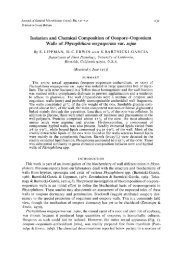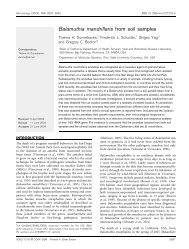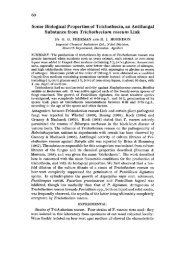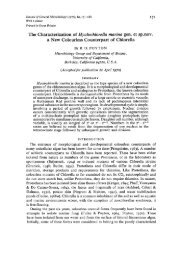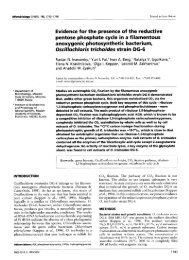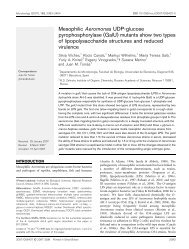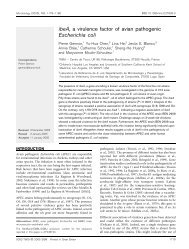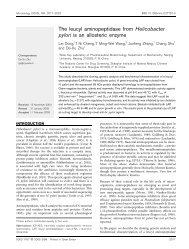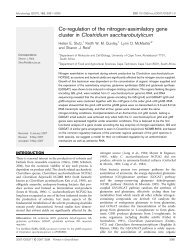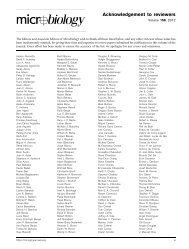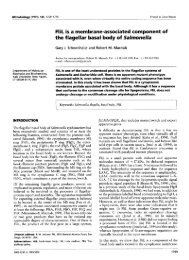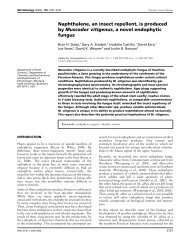Gloeocapsa (Gloeothece) sp. CCAP 143013 - Microbiology
Gloeocapsa (Gloeothece) sp. CCAP 143013 - Microbiology
Gloeocapsa (Gloeothece) sp. CCAP 143013 - Microbiology
You also want an ePaper? Increase the reach of your titles
YUMPU automatically turns print PDFs into web optimized ePapers that Google loves.
888 J. H. THOMAS AND OTHERS<br />
Table 2. Egect of inhibitors of NHT assimilation on acetylene reduction by <strong>Gloeocapsa</strong><br />
Cells were collected from batch cultures during the late exponential phase of growth (6 to 10d after<br />
inoculation). They were then incubated aerobically in the light for 4 h with 5 mM-HEPES/NaOH buffer,<br />
pH 7.5, and the compounds indicated. Acetylene was added to 2% (v/v) and the rate of acetylene<br />
reduction was measured over the following 60 min. The rates of acetylene reduction are typical; the<br />
percentages are the means of at least 12 observations.<br />
None<br />
2 mM-MSX<br />
2 m~-5-Hydroxylysine<br />
2 mM-AOCP<br />
0.2 mM-AOCP<br />
20 w-AOCP<br />
2 mM-Azaserine<br />
0.2 mM-Azaserine<br />
Acetylene reduction Percentage of<br />
[pmol min-' uninhibited<br />
Addition (lo6 cells)-'] activity<br />
24.3 100<br />
16.5 68<br />
14.9 61<br />
7.3 30<br />
11.4 47<br />
16.5 68<br />
2.8 12<br />
17.0 70<br />
2 mM-Albizziine 2.2 9<br />
2 mM-S-Carbamoyl cysteine 2.2 9<br />
2 mM-Gilutamic acid- yhydrazide 73.3 30 1<br />
2 mM-Glutamhe<br />
2 mM-Glutamate<br />
2 mM-Methionine<br />
14.9 61<br />
20.2 83<br />
19.7 81<br />
shows kinetics of competitive inhibition (Rabinowitz et al., 1957; Stewart, 1980). Both<br />
2 mM-MSX and 2 m~-5-hydroxylysine inhibited glutamine synthetase by 95 % in extracts of<br />
<strong>Gloeocapsa</strong>. N,-fixing cultures excreted NHt when incubated with 2 mM-MSX [ 12.5 pmol<br />
min-l ( lo6 cells)-'] or 2 m~-5-hydroxylysine [4- 16 pmol min-' ( lo6 cells)-']. This suggests<br />
that glutamine synthetase catalyses the initial step of NHt assimilation in <strong>Gloeocapsa</strong><br />
and is further evidence for the operation of the glutamine synthetase-glutamate synthase<br />
pathway under N,-fixing conditions.<br />
Acetylene reduction was slightly inhibited by 2 mM-MSX or 2 m~-5-hydroxylysine<br />
(Table 2). It is not clear whether simultaneous addition of 2 mM-glutamine prevented these<br />
inhibitions, because glutamine itself inhibited acetylene reduction (Table 2). Inhibition of<br />
acetylene reduction by 2 mM-MSX was prevented by addition of 2 mM-methionhe.<br />
Incubation for 4 h with 2 mM-NH,Cl markedly inhibited acetylene reduction, but addition of<br />
2 mM-MSX or 2 m~-5-hydroxylysine greatly decreased the effect of NHt (Table 3). Indeed,<br />
if allowance is made for the inhibitory effects of MSX and 5-hydroxylysine themselves (Table<br />
2), these compounds almost completely prevented NHt from inhibiting acetylene reduction.<br />
Glutamine synthetase in cultures of other cyanobacteria was inhibited by MSX at concentrations<br />
much lower than 2 mM (Stewart & Rowell, 1975; Meeks et al., 1978). However, in<br />
Gloeocapsu, 20 PM- or 0.2 mM-MSX failed to prevent NHt from inhibiting acetylene<br />
reduction, probably because MSX may be poorly assimilated by Gloeocupsa. This view is<br />
supported by the observation that simultaneous addition of either 2 mM-glutamine or 2 mMmethionine<br />
markedly lowered the effect of MSX in preventing inhibition by NHt (Table 3),<br />
probably by interfering with the uptake of MSX (Meins & Abrams, 1972).<br />
That inhibitors of glutamine synthetase prevented NHt from inhibiting acetylene reduction<br />
in Gloeocapsu suggests that NHt itself was not the inhibitor and that a product of NHt<br />
assimilation may have been involved. Addition of glutamine, itself an early product of NHt<br />
assimilation, only slightly inhibited acetylene reduction (Table 2) but glutamine may not<br />
be readily assimilated by <strong>Gloeocapsa</strong>. Alternatively, carbamoyl pho<strong>sp</strong>hate, formed from<br />
glutamine, could be the inhibitor (Gallon, 1980).



